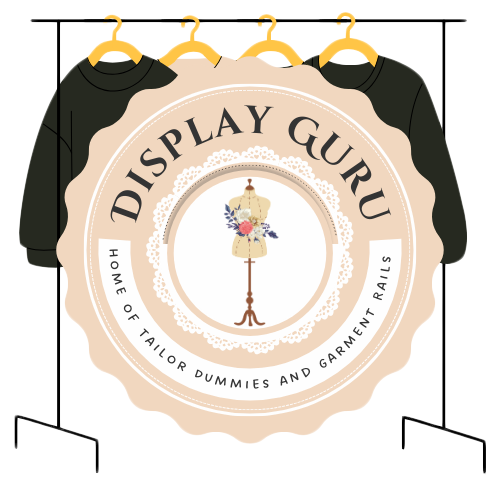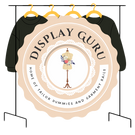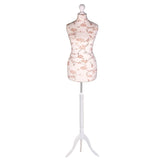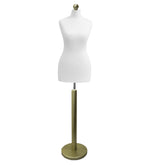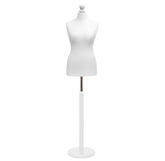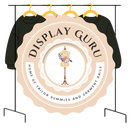How to Buy a Dress Form You'll Actually Use
Knowing how to buy a dress form starts with a simple, yet crucial, question: What will you actually use it for?
Your answer—whether for personal sewing projects, professional pattern draping, or displaying your creations—is the key that unlocks every other decision you'll make. It directly influences the size, material, and features you’ll need, ultimately determining your budget.
Defining Your Dress Form Needs
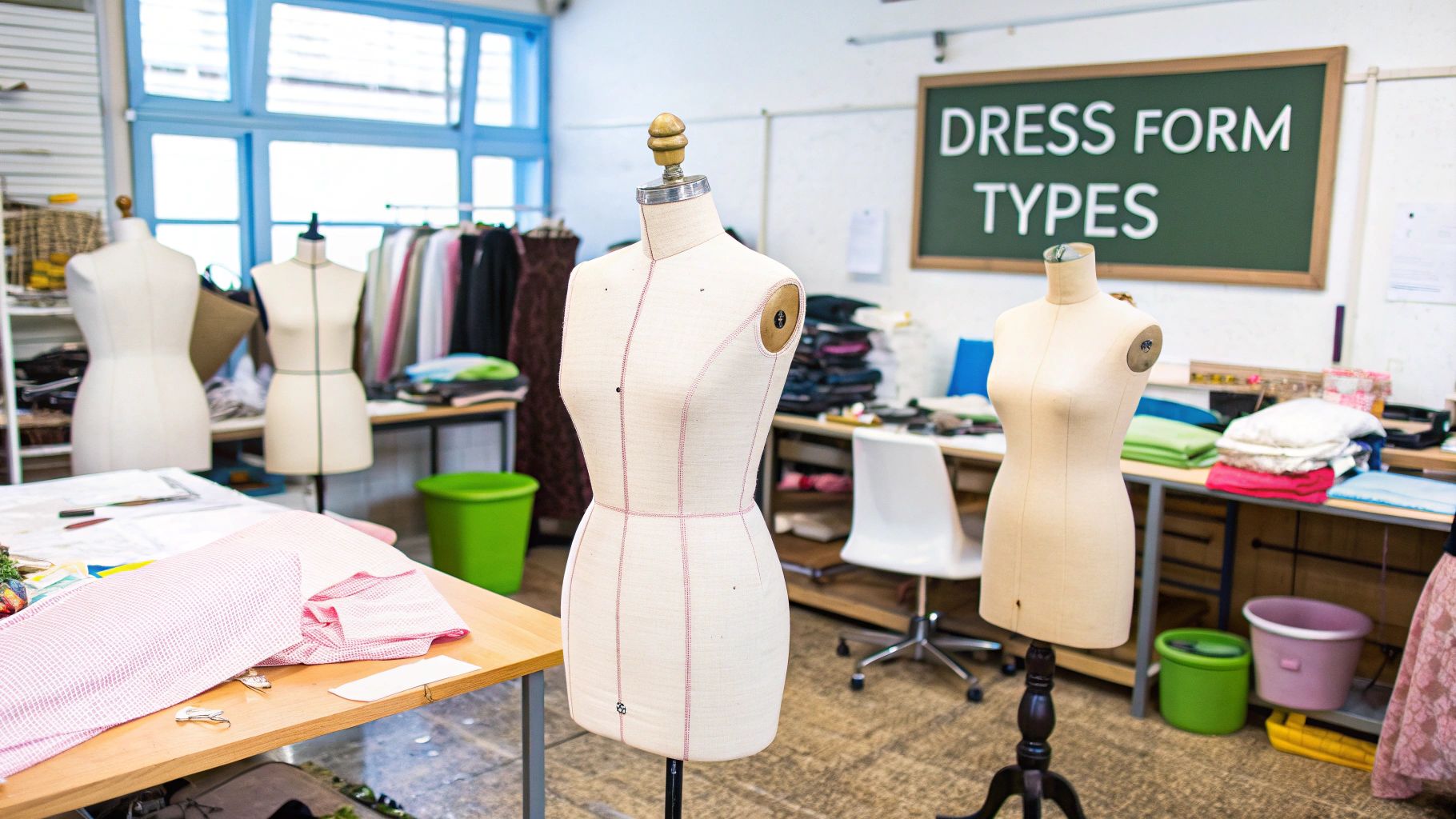
Before you dive headfirst into comparing brands and features, take a moment to clarify your purpose. A dress form isn't just another piece of equipment; it's a true investment in your craft. Get it right, and it becomes an indispensable partner in your work. Get it wrong, and it’s just a frustrating object that ends up gathering dust in a corner.
Think about your main activities. Are you a hobbyist looking to finally sew clothes that fit you perfectly? An adjustable form that can mirror your own measurements will be a game-changer. On the other hand, if you're a fashion student or a professional designer, your work likely involves draping fabric and building patterns from the ground up. For you, a robust, fully pinnable professional form isn't a luxury—it's essential.
Create Your Foundational Checklist
Understanding what you truly need from the outset saves you from overspending on features you'll never use or, even worse, buying a form that simply can't handle your projects.
Start by asking yourself a few practical questions:
- What's its primary job? Will you be draping heavy wools, fitting delicate silks, or simply using it to photograph finished pieces for your online shop?
- Whose body will it represent? Are you sewing just for yourself, or do you work with multiple clients who all have different body shapes?
- Where will it live? Do you have a dedicated studio, or does it need to be lightweight enough to move and tuck away easily?
This initial reflection is more important than you might think. Interestingly, the profile of who is buying these tools in the UK is changing. Recent research shows that women aged 35 and over are now more likely to purchase new clothing, suggesting a growing number of hobbyists and professionals in this group are ready to invest in quality tools for better, more personalised garments.
A dress form should solve problems, not create them. By defining your needs first, you ensure your investment supports your workflow instead of hindering it.
Matching Your Needs to a Form Type
To help you get started, this table summarises the main types of dress forms and who they're best suited for.
Quick Guide to Choosing Your Dress Form Type
| Dress Form Type | Best For | Key Feature |
|---|---|---|
| Adjustable Form | Hobbyists & Home Sewists | Dials allow you to change bust, waist, and hip measurements to match a specific body. |
| Professional Form | Designers, Drapers & Students | A sturdy, pinnable body (often foam over a solid core) designed for heavy use. |
| Display Form | Retailers & Exhibitors | A lightweight, often hollow-backed form designed purely for showcasing garments. |
| Bifurcated Form | Trouser & Lingerie Makers | Includes legs, making it possible to fit trousers, shorts, and other bifurcated garments. |
Having this basic understanding will help you narrow your search to the right category.
Once you have a clear picture of your goals, you can begin exploring with confidence. A home sewist, for instance, has vastly different needs from a retail merchandiser. The aim is to find a tool that makes your work more precise and, frankly, more enjoyable. To explore this further, our guide on choosing an adjustable mannequin for sewing offers deeper insights, especially for personal projects. Taking this first step properly arms you with the knowledge to find a dress form that will truly serve your creative ambitions for years to come.
Getting the Right Fit: Sizing and Adjustability
Figuring out the right size for a dress form can feel like the trickiest part of the whole process. It’s easy to get confused, especially when you see so many different types out there. The key is knowing the difference between a functional dress form, which is what we need for making clothes, and a display mannequin, which is often stylised with unrealistic proportions for shop windows. We're looking for a reliable stand-in for a human body.
First things first, you need accurate measurements. Whether you're buying for yourself or a client, precision is everything. Think of it like measuring a space for new furniture; a few centimetres off can make a huge difference. For some great general tips for accurate measurements, this is a useful starting point, but for dress forms, we focus on the body's core dimensions.
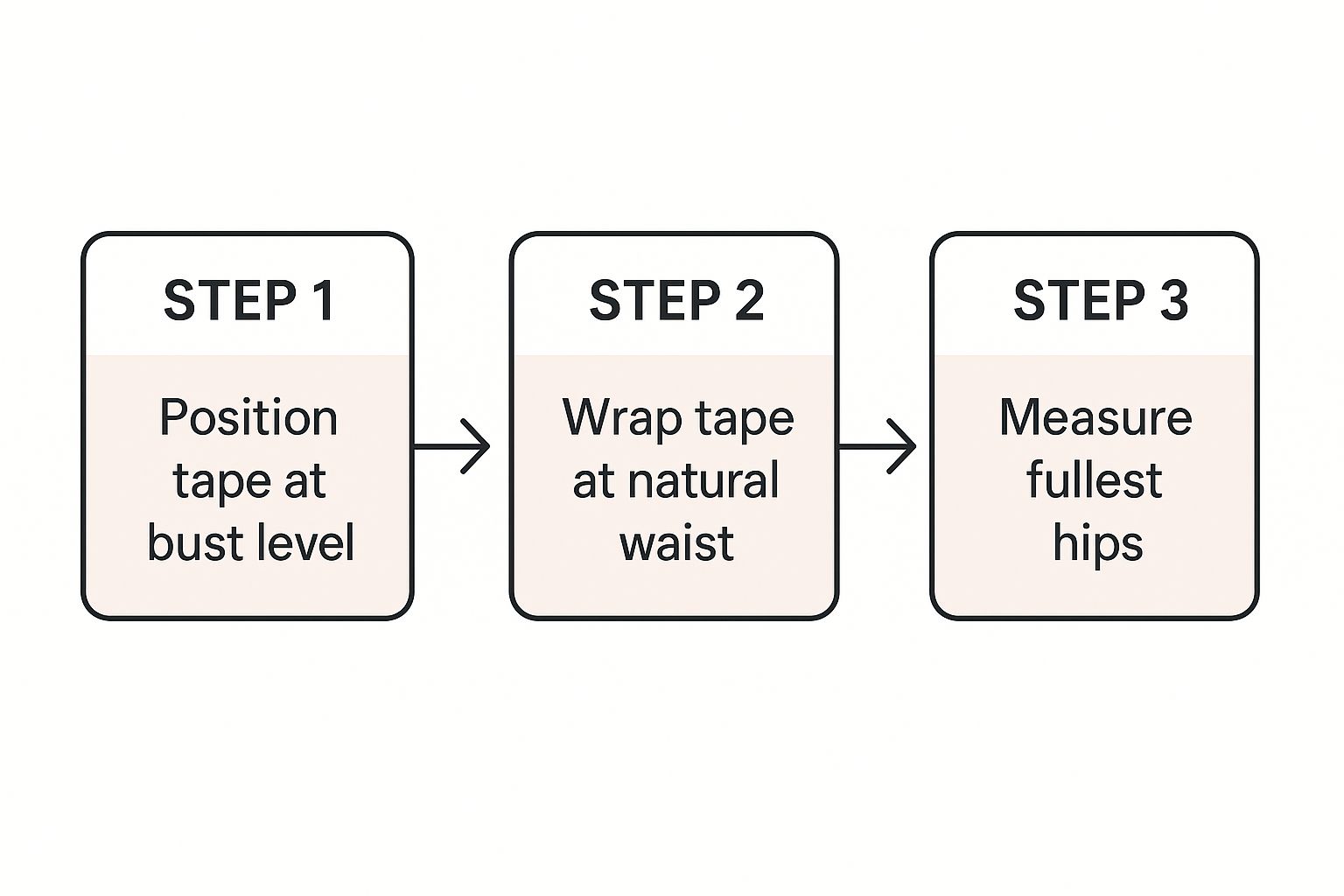
The image above breaks down the three essential measurements you’ll need to capture: the bust, the natural waist, and the fullest part of the hips. Get these numbers right, and you've got the foundation for choosing the perfect form.
Adjustable vs. Fixed Forms
Your biggest decision will be choosing between an adjustable form or a fixed-size professional one. Adjustable forms have dials—usually between 8 and 12 of them—that let you expand or shrink different sections. This can be a huge plus if you sew for people of different sizes or if your own measurements tend to change over time.
But that versatility comes at a price. When you expand the form, you create gaps between the panels. These can be a real headache, making it tricky to drape fabric evenly or pin with any confidence across the entire torso. It's tough to get a clean, continuous line.
For serious draping and pattern-making, nothing beats a professional fixed-size form. It provides a solid, fully pinnable foundation with a realistic and stable shape. There's a reason it's the industry standard.
The demand for well-fitting clothes is massive. Consider that the UK's dresses and skirts market alone is projected to hit around US$1.23 billion in 2025. That figure shows just how much people value garments that fit properly, which in turn drives the need for quality dress forms for designers and home sewers alike.
The Professional's Secret: Padding It Out
So, how do the pros get a perfect fit on a form that isn't adjustable? The secret is padding. The standard approach is to choose a form that is slightly smaller than your target measurements. From there, you use foam padding kits or layers of wadding to build up the form, meticulously matching the unique curves, posture, and proportions of the person you're fitting for.
This method gives you a level of customisation that an adjustable form just can't offer. You can account for all the little details that make a body unique, like a sway back, one shoulder being slightly lower, or asymmetrical hips.
If you work with a wide range of body shapes, learning to adapt a standard form is a crucial skill. It's especially important for creating inclusive designs. Our guide on plus-size mannequins offers insights into stylish and inclusive displays which touches upon the importance of representing diverse figures. By padding a solid base, you're not just using a tool; you're creating a truly bespoke fitting double.
Evaluating Materials and Construction
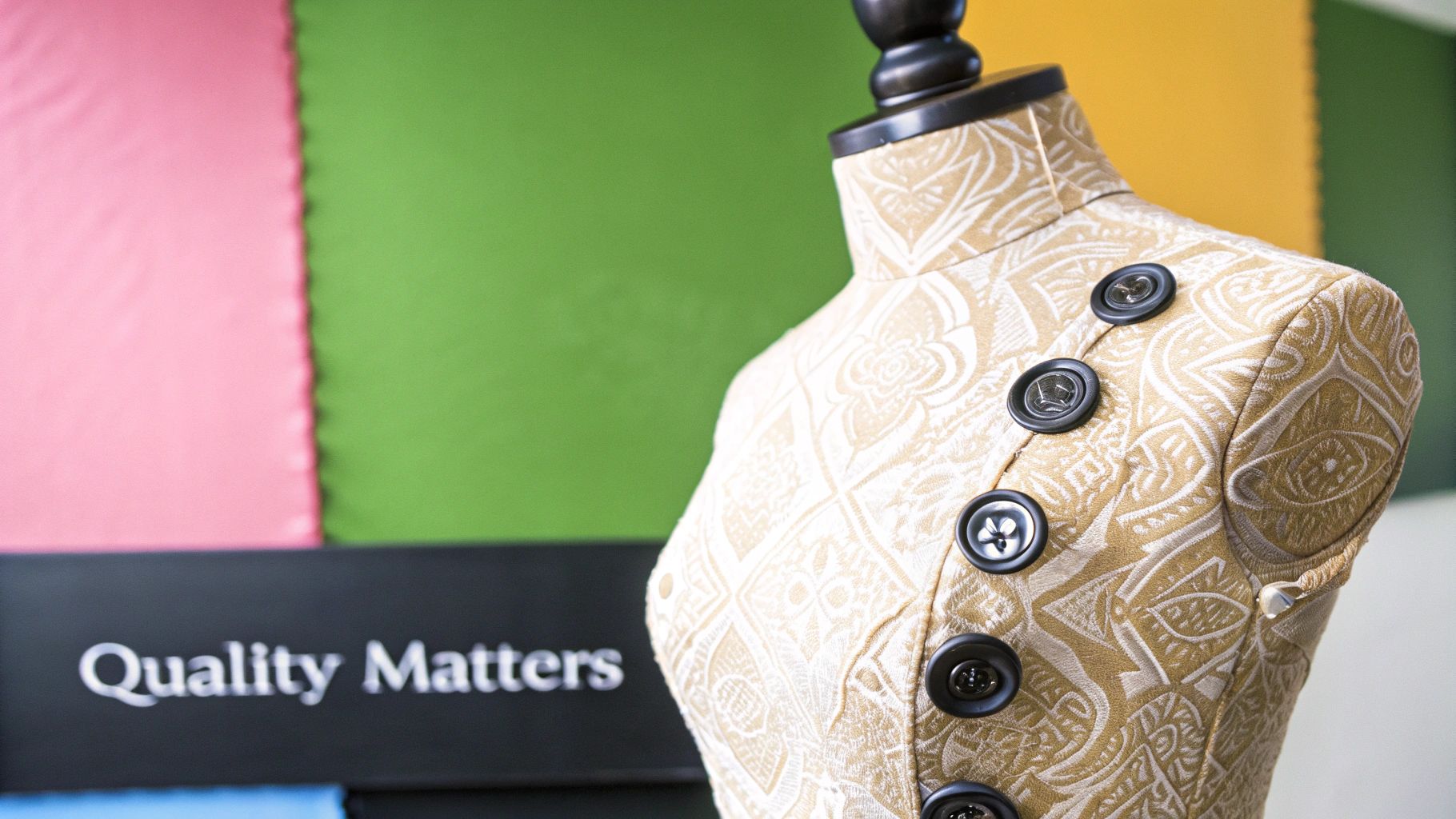
Once you’ve nailed down the right size and adjustability, it's time to get a feel for the dress form itself. The materials and overall build quality are what truly separate a helpful tool from a frustrating hindrance, defining its daily performance and how long it will last in your workspace.
Think of the form's body as your primary work surface. Its composition is absolutely crucial. Cheaper models often have a hard plastic shell you can't pin into, which severely limits their use. What you're really looking for is a pinnable surface.
The professional standard is a dense foam core wrapped in a durable linen or canvas cover. This combination gives you a firm yet forgiving surface that you can pin into again and again without it falling apart. The foam grips pins securely, which is essential for precise draping. Be wary of some entry-level forms that only have a thin layer of foam over a hollow plastic core—they simply won't stand up to serious, regular use.
Features That Genuinely Improve Your Workflow
A professional feature that's often overlooked but incredibly useful is collapsible shoulders. On these forms, the shoulder area can be compressed inwards, which is a game-changer. It lets you slip tight-fitting garments like blouses or sleeved dresses on and off without a struggle, preventing any stretching or damage to the fabric. If you work with fitted bodices, this one feature will save you an immense amount of time and frustration.
The stand is another component that deserves your full attention. The base of your dress form dictates its stability and how easily you can move it around—two factors that have a huge impact on your day-to-day work.
- Tripod Stands: Often made from wood or lighter metal, these are typically more affordable and easier to shift around. They're a solid choice if you're working in a smaller studio or home sewing space.
- Cast Iron Bases: These are the heavy-duty workhorses, usually set on wheels for mobility. If you plan to work with weighty fabrics like wool, denim, or heavily beaded materials, the extra stability from a cast iron base is non-negotiable. It's what stops the form from tipping over mid-drape.
A wobbly dress form isn't just an annoyance; it's a barrier to precision. Investing in a stable base is an investment in the quality of your own work, especially when you’re draping heavy or unbalanced garments.
Why a Solid Foundation Matters
A stable stand is fundamental to an efficient and creative workspace. A heavy cast iron base on wheels really does offer the best of both worlds: it's sturdy enough for the most demanding projects yet can be rolled out of the way or into the perfect position with ease.
This mobility is a massive advantage. You’ll constantly be moving your form to check the drape from a distance or access it from a different angle. A well-organised workspace is key, and the right stand plays a huge part in that. For more ideas on getting your space just right, take a look at our guide to the perfect sewing room setup.
When you're inspecting a potential dress form, pay close attention to the small signs of quality. Look for smooth, cleanly finished seams on the cover, a sturdy central pole that doesn't wobble, and high-quality, easy-to-use dials or keys for the adjustment points. These details are what separate a dependable, long-term tool from a purchase you’ll quickly come to regret.
Getting Your Budget Right

Let's talk money. This is where your dream dress form moves from a "maybe one day" to a real tool in your sewing space. In the UK, you can find a huge range of options, from simple models on Amazon for under £100 to professional-grade forms that can cost upwards of £500. Figuring out what you can realistically spend is the first step towards a smart purchase.
Setting a clear budget stops you from making two common mistakes: either paying a premium for features you'll never use, or trying to save a few quid on a cheap form that ends up being more trouble than it's worth. The market is surprisingly large; globally, it was valued at over USD 150 million back in 2020 and has been growing steadily. You can read more about this in a market analysis from Data Insights Market. For us, this growth simply means more choice and competitive pricing.
Understanding Price Tiers
To make sense of the options, I find it helpful to think of the market in three main tiers. Each one is geared towards a different type of sewer with different needs.
Before diving into a full comparison, it’s worth noting that the jump in price between tiers usually comes down to durability, adjustability precision, and material quality. A higher price often means a heavier, more stable base and a body that can withstand years of pinning and steaming.
Feature Comparison Across Price Tiers
Here’s a look at what you can generally expect to get for your money. This table breaks down the common features and intended uses for dress forms across different price points in the UK market.
| Price Tier | Typical Price Range (£) | Common Features | Ideal For |
|---|---|---|---|
| Entry-Level | £80 - £150 | Adjustable dials, basic stand, thin fabric cover, limited pinnability. | Beginners, occasional hobbyists, or for simple fitting tasks. |
| Mid-Range | £150 - £350 | More robust adjustable dials, sturdier stands, fully pinnable foam, better quality cover. | Serious home sewists, fashion students, and small business owners. |
| Professional | £350+ | Fixed-size heavy-duty body, cast iron base with wheels, collapsible shoulders, premium linen cover. | Professional designers, pattern makers, and high-volume studios. |
This breakdown should help you match your budget to the features that will actually make a difference in your work. There’s no point in a beginner buying a professional form, just as a seasoned designer would find an entry-level model far too limiting.
Your budget should be a direct reflection of your needs. Pay for the features that will actively support your workflow, not just the ones that sound impressive.
Finding Reputable UK Sellers
Where you buy from is almost as important as what you buy. While big marketplaces seem to offer the best deals, specialist suppliers bring something more valuable to the table: expertise.
I always recommend looking for dedicated UK-based sewing shops or mannequin retailers. They've seen it all and can offer genuine advice to steer you towards the right model for your specific projects.
Before you click "buy," always do your homework:
- Read product descriptions thoroughly.
- Scour customer reviews for insights on build quality and long-term durability.
- Check the returns policy, just in case.
For more detailed advice on what to look for in product specs, our guide on using dress forms for sewing offers some great pointers. By investing a little time and thought into your purchase, you'll end up with a reliable partner that supports your creative journey for years to come.
You've done the hard work, weighed the options, and finally picked the perfect dress form. Getting it from the online store into your workspace is the final piece of the puzzle, but don't skip over these last crucial steps. A little diligence now ensures a smooth start with your new creative partner.
Before you rush to the checkout, pause for a moment. With a bulky item like a dress form, the fine print really matters. Take a close look at the seller's policies.
The return policy is your safety net. What’s the return window? Who covers the cost of return shipping (which can be substantial)? Are there any sneaky restocking fees? Next, check the warranty. You need to know what’s covered if a dial seizes up or the stand becomes wobbly. Finally, confirm the shipping costs and delivery estimates—these can vary wildly for oversized packages.
Getting It Assembled and Ready for Work
When that big box lands on your doorstep, it’s an exciting moment. Most dress forms are fairly straightforward to assemble—it’s usually just a case of connecting the pole to the base and mounting the torso. Still, keep the instructions nearby, especially if you have an adjustable model with specific mechanisms or keys to attach.
Once it's standing tall, the real work begins. This is how you turn a generic mannequin into your personal body double.
-
Dial in the Measurements: If your form is adjustable, now’s the time to set your precise bust, waist, and hip measurements. Keep a tape measure handy to double-check your adjustments for accuracy.
-
Get a Padded Cover: Adjustable forms often have gaps and ridges between the dials. A good padded or quilted cover smooths everything out, giving you a consistent, pinnable surface. This is also how the pros tweak a standard professional form to perfectly match a client's unique shape.
-
Mark Your Reference Lines: This simple trick is what separates a basic form from a professional fitting tool. Grab some twill tape or thin ribbon and mark the key horizontal lines: bust, waist, and hip. Don't forget the vertical centre front and centre back lines, either. These guides are indispensable for making sure your garments hang straight and are perfectly balanced.
Don’t treat prepping your form as an afterthought—it’s a foundational step. Taking the time to do this properly will save you countless hours of fitting headaches and ensure every garment you make is accurate from the start.
With your form all set up, you can start thinking about its other uses. If you're planning to sell your creations, your perfectly prepped dress form is an ideal model for taking stunning visuals, like professional fashion product photos, that will make your work look its absolute best.
Answering Your Top Dress Form Questions
When you're ready to get serious about your sewing, a few questions about dress forms always seem to pop up. Answering these early on is the key to buying the right tool for the job, one you'll be happy with for years to come. Let's walk through the most common queries I hear from fellow makers.
Adjustable or Professional? It Depends on Your Work
One of the first decisions you'll face is whether to go for an adjustable form or a fixed-size professional one. There's a big difference in how they function.
If you mainly sew for yourself and your measurements tend to change, or if you're making clothes for a few different people, an adjustable form can be a great, flexible option. It lets you dial in the bust, waist, and hip measurements for each individual project.
However, if you're serious about pattern making, draping, or running a business, a professional fixed-size form is the way to go. Fashion students and established designers rely on them for a reason. They're built like tanks, offer a much more accurate silhouette, and are fully pinnable, providing the kind of stable, industry-standard canvas you need for precise work.
How Do I Find a Form That Matches My Body?
Everyone hopes to find a dress form that's an exact replica of their body right out of the box. I hate to be the one to break it to you, but that's practically impossible. Every single body is unique, with its own specific curves, posture, and proportions.
The secret isn't finding a perfect match; it's creating one. The professional technique is to buy a high-quality, fixed-size form that's a little smaller than your own measurements. From there, you use padding to build it up. This is how you create a truly custom fitting double that mirrors everything from a rounded tummy to a sway back.
An off-the-shelf form is a starting point, not the final destination. The real magic happens when you customise it to reflect a real body, whether it's your own or a client's. This is what elevates a good fit to a perfect one.
Aren't Dress Forms and Mannequins the Same Thing?
It’s a common mix-up, but "dress form" and "mannequin" are not interchangeable terms. They are designed for completely different purposes, and knowing the difference will save you a lot of frustration.
- Mannequin: This is purely for display. You see them in shop windows, styled to look attractive and sell clothing. They're typically made of hard, unpinnable materials like fibreglass or plastic and often have stylised, unrealistic figures.
- Dress Form: This is a working tool for sewing and design. It’s built with realistic body proportions, covered in a pinnable fabric like linen or canvas, and designed to stand up to the constant pinning, draping, and fitting that garment construction demands.
The simplest way to think about it is that a mannequin is for showing, while a dress form is for doing. The stability of the stand is also a huge factor. For a deeper dive into what to look for, you can learn more about the importance of a quality dress form stand and how it affects your entire workflow. When you choose a real dress form, you're investing in workshop equipment, not just a pretty display piece.
At Display Guru, we offer a wide range of professional-grade and adjustable dress forms to support your entire creative journey. Take a look at our collection and find the perfect partner for your sewing studio at https://www.displayguru.co.uk.
